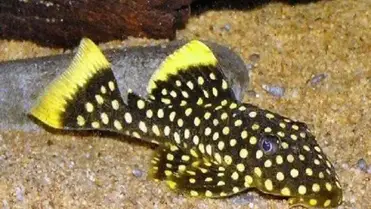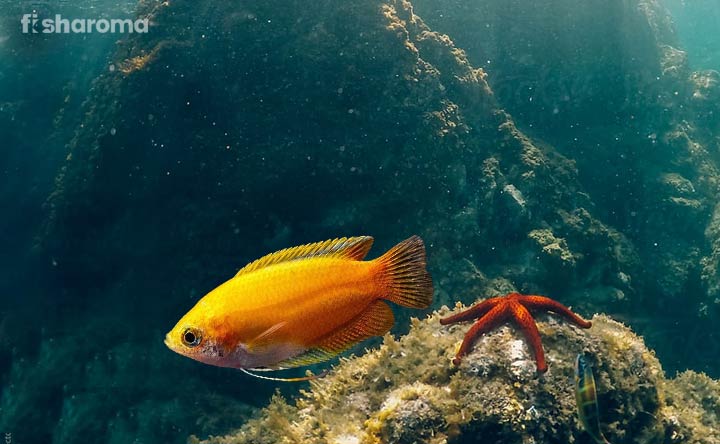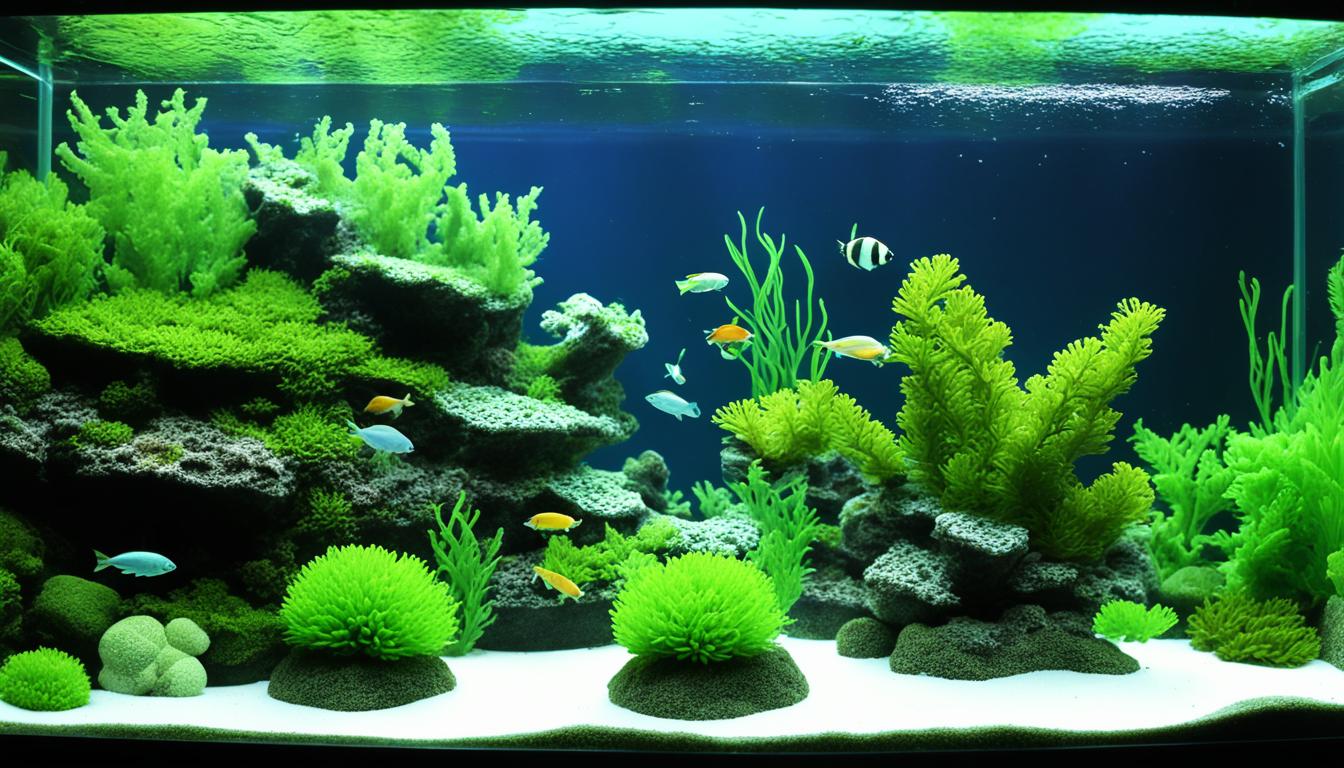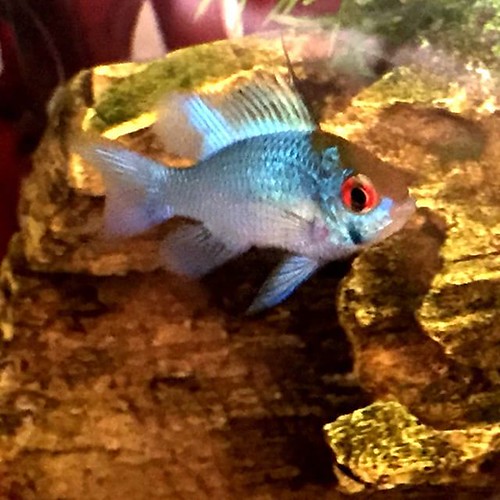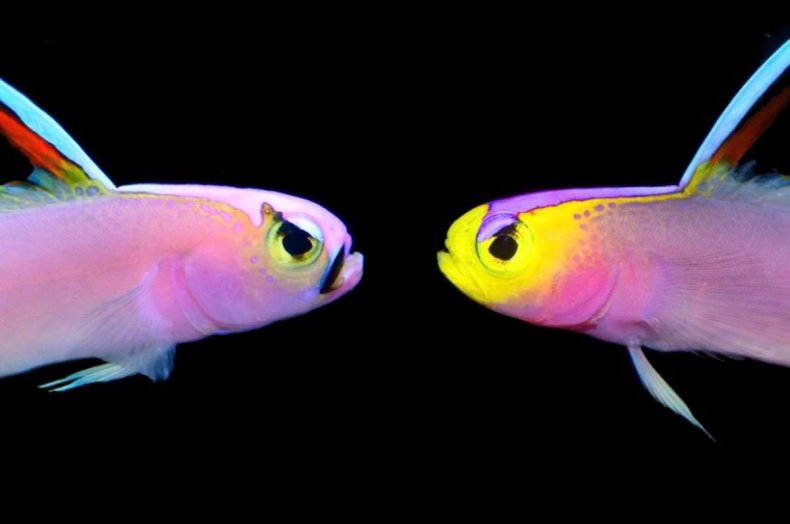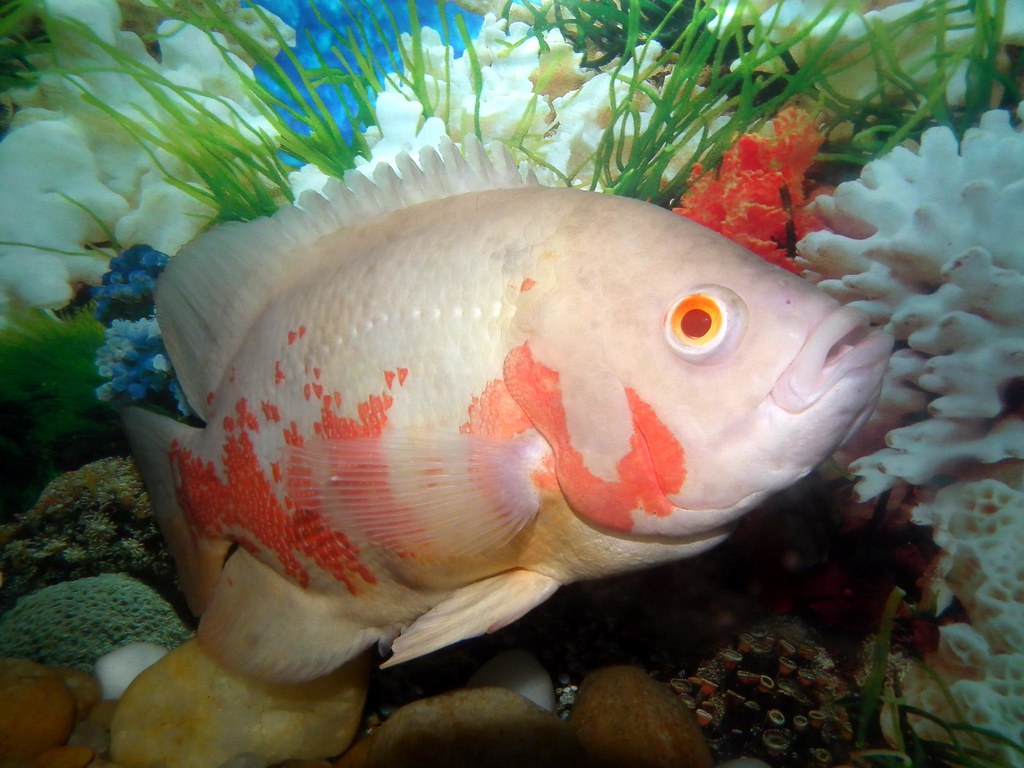German Blue Ram Breeding: Did you know German blue ram cichlids can live up to 4 years with the right care? These beautiful fish shine with iridescent colors and have a bold character. They attract many fish keepers. Learning to breed German blue rams effectively is rewarding for both new and skilled breeders.
Table of Contents
German Blue Ram Breeding Key Takeaways:
- German Blue Rams are known for their iridescent colors and confident personality.
- They typically grow to be between 2-2.5 inches long.
- Proper care can extend their lifespan up to 4 years.
- You can source German Blue Rams from overseas fish farms, domestic fish farms, or local breeders.
- A pair of German Blue Rams can be kept in a 20-gallon community tank or a 10-gallon breeding tank.
What are German Blue Rams?
German Blue Rams, or Mikrogeophagus ramirezi, are a kind of dwarf cichlid from South America. They come from the Orinoco River area in Colombia and Venezuela. People love them for their shiny colors and bold nature. They’re also called ram cichlids, blue rams, or butterfly cichlids.
These fish are a favorite in the fish tank world, thanks to their bright blue hues and special looks. The German-bred kinds are especially popular for their beauty.
They’re small, growing only about 2-2.5 inches long. While they’re tinier than Bolivian rams, their amazing colors and fins stand out.
With the right care, German Blue Rams can live for up to 4 years. Keeping their water clean and at the right temperature, 84-86°F, is key for their health.
Most German Blue Rams come from fish farms in places like Florida or from local breeders. Fish from places like Florida are often in better shape. Local breeders might offer fish that do well in your area’s water.
Thinking about getting German Blue Rams? Make sure they have enough room. A 20-gallon tank works well for a pair. For more pairs, a 40-gallon tank is better to give them space.
These fish are mostly peaceful but do like their space. They live well with fish like tetras and cory catfish. But avoid putting them with aggressive fish.
Breeding German Blue Rams in a tank is quite easy. For the best chance at babies, feed them well and set up a special breeding tank. Good conditions and the right setup can help a lot.
Different Types of Ram Cichlids
Ram cichlids are a favorite among fish lovers for their variety. They come in many types and colors, each unique in look and traits.
Regular Ram
The regular ram is a top pick for its bright colors and shape. It is small, reaching 2-2.5 inches, ideal for little tanks.
Long Fin Ram
The long fin ram boasts elegant, lengthy fins. It resembles the regular ram but with longer fins. These fins give it grace and beauty in the water.
Balloon Ram
The balloon ram stands out with its round body. This look comes from special breeding. It keeps the vibrant colors of its family.
German Blue Rams
German blue rams are a favorite for their blue colors. They brighten any aquarium and can live up to 4 years with good care.
Gold Rams
Gold rams add warmth with their gold-yellow color. They bring a lively spark to tanks and live about 2-3 years.
Electric Blue Rams
Electric blue rams have a striking blue color. Their bold hue is unforgettable. They do well in soft or low GH water.
Every aquarist can find a ram cichlid to love. You have many choices like the regular, long fin, balloon, German blue, gold, or electric blue ram. Each adds its own beauty and charm to your tank.
Size and Lifespan of German Blue Rams
German Blue Rams, also known as Mikrogeophagus ramirezi, are relatively small fish. They usually grow to be about 2-2.5 inches (5-6 cm) long. They’re a bit smaller than their relatives, the Bolivian ram cichlids.
With good care, German Blue Rams can live for up to 4 years. Their life length can change based on things like how they’re bred and how well they’re taken care of.
To keep German Blue Rams healthy and long-lived, consider what they need. Having the right tank setup, including the correct temperature, clean water, and enough space, is key to their well-being and long life.
| German Blue Ram Size | German Blue Ram Lifespan |
|---|---|
| 2-2.5 inches (5-6 cm) | Up to 4 years |
The data reveal that German Blue Rams are small fish with a potential for a long life through proper care. By learning about their needs and creating the right living space, fish owners can enjoy these lovely fish for years.
Where to Buy German Blue Rams
Looking to buy German Blue Rams? There are several sources like overseas and domestic farms, or local breeders. Each has its benefits and things to think about.
1. Overseas Fish Farms: Many stores get German Blue Rams from abroad. These places offer lots of colors and patterns. Yet, be careful. Some use hormones which might harm the fish’s health over time.
2. Domestic Fish Farms: In the U.S., domestic farms are becoming go-to places for these fish. These farms focus on the health and strength of the fish. Buying domestically means the fish are likely to do well because they’re used to similar water conditions.
3. Local Breeders: Buying from local breeders is another great choice. They offer fish adapted to your area’s water. Plus, you get helpful tips and support from them directly.
Pick healthy, bright, and active German Blue Rams. Avoid any that seem sick or stressed.
| Size | Lifespan | Preferred Water Parameters |
|---|---|---|
| Full-grown male: 3 inches long, 10 grams | Up to 4 years | Temperature: 78-82°F Hardness: PH: 6.2-6.8 |
Setting Up a German Blue Ram Aquarium
Creating the right home for your German Blue Rams is key. A well-set-up tank will make them feel at home and help them thrive. It’s about making a space that looks like where they come from naturally.
Keeping the water warm is super important for these fish. They do best in temperatures between 84-86°F. This warmth is vital for their health and for making baby fish.
Add live plants like java fern and moss to make the tank look nice. These plants offer hiding spots and make the tank more like their natural home. They also keep the water clean and full of oxygen.
Good water quality is a must for these fish. Do regular water changes and keep an eye on the water’s chemistry. Though these fish can handle different pH levels, they prefer softer water. Adding things like Indian almond leaves can make the water just right for them.
It helps to have spots in the tank where the fish can lay eggs. Use flat stones or small pots for this. More spots mean a better chance for the fish to have babies.
| Tank Size Recommendations | Recommended Tank Size |
|---|---|
| Pairs of German Blue Rams | 20-gallon community tank or 10-gallon breeding tank with no other fish |
| Two pairs of German Blue Rams | 40-gallon aquarium or larger |
A 20-gallon tank works for a pair of rams if it’s a community tank. For breeding, a 10-gallon tank is enough. For two pairs, you’ll need at least a 40-gallon tank. This helps avoid fights over space.
Make sure the tank has lots of plants and places to hide. This makes the fish feel safe and keeps them happy. A well-decorated tank is great for the fish and looks amazing too.
Follow these steps to make a great home for your rams. Keep the water clean and the tank well cared for. This way, your fish will be healthy and might even have babies.
Social Behavior and Tankmates for German Blue Rams
German blue rams are peaceful fish that make great additions to community tanks. But, you must think about their social behavior and pick the right tankmates. This ensures a happy aquarium setting.
Though they’re usually calm, German blue rams might claim territories during breeding. They do this more in small tanks. Avoid fights by giving each fish enough space and hiding spots. This lets them have their own areas.
It’s key to select tankmates for German blue rams that like the same warm water. They should also be okay with the water conditions rams need. Some good choices include:
- Tetras: Neon, cardinal, and rummy nose tetras work well. They bring color and calm to the tank.
- Cory Catfish: Sterbai cory catfish are great since they have similar water needs and stay low, causing no trouble.
- plecos: Smaller plecos, like the Bristlenose, live peacefully with rams. They also keep algae in check.
- Discus: German blue rams and discus both enjoy warm water and are peaceful. Make sure the tank is big and watch how they get along.
- Dwarf Cichlids: Apistogramma and keyhole cichlids can be nice tankmates too. They act similarly and like the same water.
Steer clear of aggressive or large fish that might threaten rams or compete too much. It’s also key to watch how new tankmates get along. You may need to adjust if there are issues.
Choosing the right tankmates means creating a community where every fish is happy. By taking the peaceful nature of German blue rams and fish compatibility into account, you’ll have a beautiful, balanced tank.
Feeding German Blue Rams
Feeding German Blue Rams is key to their health. These fish are easy to feed, liking both dry and frozen foods. A mix of protein and veggies in their diet helps keep them vibrant and healthy.
Good food choices include quality pellets, freeze-dried bloodworms, and tubifex worms. You can also give them brine shrimp and mysis shrimp from pet stores or online.
Feed them twice daily as they grow, but only once as adults. This helps them get the right amount of nutrients. Avoid overfeeding to prevent water pollution and health issues.
A varied diet not only boosts their color but also supports their health and internal system functions.
Optimal Diet for German Blue Rams
In the wild, German Blue Rams eat both meat and plants. We should copy this diet in captivity to keep them healthy. Mixing protein-rich foods with veggies covers their nutritional needs.
You can also offer them live and frozen treats to brighten their colors and encourage hunting behavior. Treats like baby brine shrimp and daphnia are great for them. These foods are nutritious and help with breeding.
Using live and frozen foods offers many benefits over flakes. They’re more nutritious, improve coloration, and encourage natural behaviors.
Special Considerations for Breeding Rams
For breeding German Blue Rams, offer them a diet rich in quality foods. Adding live baby brine shrimp aids in egg production and healthy fry.
Feed the breeding pair quality pellets and live brine shrimp twice a day. A balanced diet improves breeding success and fry health.
Watch how your fish eat and change their diet as needed. It’s crucial to keep their meals varied yet moderate for their best health.
Breeding Techniques for German Blue Rams
Breeding German Blue Rams is both exciting and rewarding. They are known for their vibrant colors and fun behavior. To breed them successfully, the right conditions and techniques are vital.
Start by conditioning the breeding pair with high-quality foods. Foods like live baby brine shrimp are ideal. This prepares them for breeding.
Create a special breeding tank with the right tools. This includes a sponge filter and a heater to keep the water at 80° to 86°F (27° to 30°C). You also need flat rocks or terracotta pots for the eggs.
German Blue Rams are monogamous and both parents help with the eggs. When ready, they’ll perform courtship rituals. The female lays up to 500 eggs, then the male fertilizes them. Be aware they might eat their eggs, so take steps to protect them.
The parents take turns guarding the eggs. Keeping the water clean is critical during this stage. Test the water regularly and do partial changes to keep conditions stable.
Once the eggs hatch, the fry need special care. Start by feeding them infusoria, tiny organisms, as their first food. Later, introduce baby brine shrimp and quality fry powder. A varied diet is key to their growth.
In conclusion, with the right techniques, breeding German Blue Rams can be successful. Condition the pair, prepare a special tank, and care for the eggs and fry properly. Excellent water quality and a good diet are essential for their wellbeing.
Tank Size and Pairing for Breeding German Blue Rams
When breeding German Blue Rams, the right tank size and mate choice is key. A big enough tank helps these pretty fish establish their own spaces and avoid fights. Let’s look into the best tank size and pairing ways for a good breeding setup.
Optimal Tank Size
A 20-gallon tank is the least you need for breeding German Blue Rams. This lets a pair or trio make their own areas and breed easily. Want more pairs? Go for a 40-gallon tank. It’s better for peace among pairs, decreasing fights.
The tank setup also needs thought. Put in lots of hiding spots and barriers like plants, rocks, and caves. These make separate areas and keep the pairs feeling safe. It lowers stress, helping with breeding success.
Pairing Recommendations
Pairing a male and a female German Blue Ram is best for breeding. In the wild, they pair up for life, and they do the same in tanks. They show sweet courting behaviors, lay eggs, and both take care of their young.
Don’t put two males or two females together, as it causes fighting. A single pair or trio in one tank is perfect. It makes a calm space for breeding, with fewer conflicts.
With the right tank and mating choices for German Blue Rams, you set up a space that boosts natural breeding acts. This ups your chances of having baby fish. Don’t forget about hiding places, good water, and watching the fish closely. This keeps your German Blue Rams healthy and happy during breeding.
Caring for Fry and Raising German Blue Rams
Once the fry hatch, they start by eating their egg sacs. You can feed them infusoria and live baby brine shrimp for good growth. The parents usually protect the fry. But sometimes, you might have to remove them to stop aggression or the eating of fry.
Proper tank conditions, regular water changes, and right feeding times help the fry grow well. They become healthy juvenile German Blue Rams.
| Fry Care | Raising German Blue Rams |
|---|---|
|
|
By carefully following these steps and providing the right care, raising healthy German Blue Rams is totally possible in your aquarium.
Conclusion
Breeding German Blue Rams can be very rewarding. It’s great for aquarists at all levels. You need to understand their behaviors and give them the right tank conditions. Then, you can breed and raise healthy German Blue Rams.
Space is key for these fish. They can grow over 7 cm long. So, they need a tank of at least 75 L (20 gallons). If you have more than one pair, you’ll need bigger tanks.
Water quality is crucial for breeding success. German Blue Rams like slightly acidic water, with a pH between 5 and 7. You must change the water regularly to keep it clean.
Diet impacts their health and breeding success, too. Since they eat both animal and plant foods, a varied diet is essential. A good diet ensures they stay healthy and colorful.
German Blue Rams pair up for life and care for their young together. Pick tank mates carefully to prevent stress. Also, add hiding places and spawning surfaces to encourage breeding.
With patience and proper care, breeding these fish is rewarding. You’ll see the beauty and interesting behaviors of German Blue Rams. It’s a great way to explore nature from home.
FAQ
What are German Blue Rams?
What are the different types of Ram Cichlids?
How big do German Blue Rams get and what is their lifespan?
Where can I buy German Blue Rams?
How do I set up a German Blue Ram aquarium?
Can German Blue Rams be kept with other fish?
What do German Blue Rams eat?
How do I breed German Blue Rams?
What is the recommended tank size for breeding German Blue Rams?
How do I care for and raise German Blue Ram fry?
References
The South American Cichlid Association (SACA)
The American Cichlid Association (ACA)British Cichlid Association
I am a passionate aquarist with over 30 years of hands-on experience in fishkeeping. My journey began at a young age, collecting fish from the wild and learning through experimentation. Specializing in tropical fish, I bring a deep understanding of the hobby to FishKeepingMadeSimple. The site provides honest, detailed reviews of essential products and accessories to help fellow enthusiasts create the best environments for their fish.




